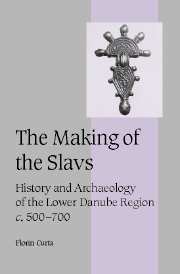Book contents
- Frontmatter
- Contents
- List of figures
- List of tables
- Acknowledgments
- List of abbreviations
- Introduction
- 1 Slavic ethnicity and the ethnie of the Slavs: concepts and approaches
- 2 Sources for the history of the early Slavs (c. 500–700)
- 3 The Slavs in early medieval sources (c. 500–700)
- 4 The Balkans and the Danube limes during the sixth and seventh centuries
- 5 Barbarians on the sixth-century Danube frontier: an archaeological survey
- 6 Elites and group identity north of the Danube frontier: the archaeological evidence
- 7 “Kings” and “democracy”: power in early Slavic society
- Conclusion: the making of the Slavs
- Appendix A
- Appendix B
- References
- Index
- Cambridge Studies in Medieval Life and Thought Fourth series
Introduction
Published online by Cambridge University Press: 08 July 2009
- Frontmatter
- Contents
- List of figures
- List of tables
- Acknowledgments
- List of abbreviations
- Introduction
- 1 Slavic ethnicity and the ethnie of the Slavs: concepts and approaches
- 2 Sources for the history of the early Slavs (c. 500–700)
- 3 The Slavs in early medieval sources (c. 500–700)
- 4 The Balkans and the Danube limes during the sixth and seventh centuries
- 5 Barbarians on the sixth-century Danube frontier: an archaeological survey
- 6 Elites and group identity north of the Danube frontier: the archaeological evidence
- 7 “Kings” and “democracy”: power in early Slavic society
- Conclusion: the making of the Slavs
- Appendix A
- Appendix B
- References
- Index
- Cambridge Studies in Medieval Life and Thought Fourth series
Summary
Mein Freund, das ist Asien! Es sollte mich wundern, es sollte mich höch-lichst wundern, wenn da nicht Wendisch-Slawisch-Sarmatisches im Spiele gewesen wäre.
(Thomas Mann, Der Zauberberg)To many, Eastern Europe is nearly synonymous with Slavic Europe. The equation is certainly not new. To Hegel, the “East of Europe” was the house of the “great Sclavonic nation,” a body of peoples which “has not appeared as an independent element in the series of phases that Reason has assumed in the World”. If necessary, Europe may be divided into western and eastern zones along a number of lines, according to numerous criteria. Historians, however, often work with more than one set of criteria. The debate about the nature of Eastern Europe sprang up in Western historiography in the days of the Cold War, but despite Oskar Halecki's efforts explicitly to address the question of a specific chronology and history of Eastern Europe, many preferred to write the history of Slavic Europe, rather than that of Eastern Europe. Today, scholarly interest in Eastern Europe focuses especially on the nineteenth and twentieth centuries, the period of nationalism. The medieval history of the area is given comparatively less attention, which often amounts to slightly more than total neglect. For most students in medieval studies, Eastern Europe is marginal and East European topics simply exotica. One reason for this historiographical reticence may be the uneasiness to treat the medieval history of the Slavs as (Western) European history.
- Type
- Chapter
- Information
- The Making of the SlavsHistory and Archaeology of the Lower Danube Region, c.500–700, pp. 1 - 5Publisher: Cambridge University PressPrint publication year: 2001

